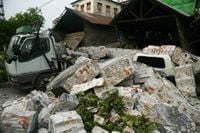A powerful earthquake measuring 7.7 on the Richter scale struck near Mandalay, Myanmar, on March 28, 2025, at 12:50 PM local time, causing widespread destruction and chaos. The epicenter was located approximately 10 kilometers from the city, leading to significant tremors felt as far away as Thailand, where reports of minor damage were also noted.
According to the National Disaster Relief Team, the earthquake has resulted in at least 1,644 confirmed deaths and left more than 3,400 individuals injured. Additionally, 139 people remain unaccounted for, and efforts to locate survivors have been hampered by aftershocks and damaged infrastructure. This earthquake is being described as one of the most devastating natural disasters to hit Myanmar in decades, with damage comparable to the 2015 earthquake in Nepal.
The Sagaing Fault, often referred to as the "sleeping giant" of Myanmar, is responsible for this seismic event. Stretching 1,500 kilometers, this strike-slip fault has a history of significant earthquakes, with over 70 recorded events greater than 7.0 magnitude since 1429. The last major quake occurred in 1912, measuring 8.0 and devastating the region.
In response to the disaster, the Myanmar government has declared a state of emergency in the affected areas, calling for international assistance. Many citizens have been forced to evacuate their homes, and temporary shelters are being established to accommodate those displaced. Hospitals are overwhelmed, facing shortages of medical supplies and equipment.
Local residents have taken it upon themselves to search for survivors, often risking their own safety as they dig through rubble with bare hands. Reports indicate that rescue operations are facing numerous challenges, including a lack of tools and unstable communication systems. Roads and bridges have been severely damaged, complicating access to the hardest-hit areas.
International aid has begun to arrive, with Thailand sending 55 rescue workers to assist in recovery efforts. The Indian Air Force has also dispatched humanitarian supplies, while teams from China, Russia, Malaysia, and Singapore are on their way to provide support. South Korea has pledged $2 million in initial humanitarian aid through various international organizations.
As of March 30, the situation remains dire. The United Nations Office for the Coordination of Humanitarian Affairs (OCHA) has reported that the highways connecting major cities, including Yangon, Naypyidaw, and Mandalay, have suffered damage, which is further hindering relief efforts. The government is working to assess the extent of the damage and prioritize aid distribution to the most affected areas.
In a notable rescue operation, emergency teams managed to pull a woman from the debris of a collapsed 12-story apartment building in Mandalay after she had been trapped for over 30 hours. However, the Red Cross estimates that more than 90 people may still be trapped in the same building.
In the aftermath of the earthquake, the Myanmar government is focused on establishing field hospitals and temporary medical camps to provide immediate care to those in need. The runway at Mandalay Airport has been damaged, complicating the arrival of further aid and rescue teams. Efforts to repair the infrastructure are underway, but it is expected to take time before normal operations can resume.
The Sagaing Fault's historical activity poses ongoing risks, and experts warn that the region may experience further seismic events. The last major earthquakes linked to this fault have demonstrated its capacity to cause extensive damage not only within Myanmar but also in neighboring countries like Thailand, where soft soil amplifies seismic waves.
As the situation develops, the focus remains on rescuing those trapped, providing medical care to the injured, and ensuring that essential supplies reach the affected populations. The international community's response will be crucial in the coming days as Myanmar grapples with the aftermath of this devastating earthquake.







